You have a newly purchased antique scent bottle. You bought it just because you like it, but you know little about it. At the very least you may want to know what it’s made of, where it was made, when it was made, who made it. Yes, you can take it to “Treasures Found” at the next IPBA Convention. You can look in collector books or on the IPBA website. You can ask a question on the IPBA Facebook interactive discussion page, but where do you start?
This article focuses on a three-step process for examining your bottles and identifying features and characteristics that are clues as to the “who, what, when and where” of their origin. Three examples illustrate the three steps and give you some tips for your further research. These steps guide you through a detailed examination and description of the bottle itself.
Getting to Know Your Bottle
Step 1: What do you notice first when looking closely at your bottle?
• Material such as glass, porcelain, metal, stone, ivory/bone, other. Can the material date the bottle to a particular period? Have you seen others similar?
• Decoration on the bottle’s surface, if any. Is there paint/enamel, engraving, carving, metal or attached metal work, gemstones, other? Sometimes these decorative elements are characteristic of a period, place or maker. Are you familiar with any or have you seen any similar?
• Style features, such as shape, size, decorative elements, closure device, hinge style on cap, figural stopper and others. Are these style elements related to, or characteristic of, a particular period or country (e.g., Rococo—term for very ornate ornamentation style used extensively in France in the 18th century; also, Rococo Revival in later 19th century France, etc.)?
• Metal (or other) mounting—how much exists on the bottle (top, neck, foot, cage work)? What’s the material (silver, gold, brass, other)? Does the mounting contain any kind of marks that help date it (e.g., maker’s mark, country of origin mark, quality mark)? A resource for marks is Tardy’s Poinçons D’Argent or International Marks on Silver, available in many editions.
Step 2: What characteristics and details did you find in your examination that may help frame the scent bottle in a particular period or country of origin?
The examples shown below will illustrate how certain features can be studied more closely to aid in your identification.
Step 3: What insights can you gain? What information can you look for and where?
You will want to compare your scent container to others. Look first for bottles of known origin in your own collection that may have one or more similar features. Look at resources on the IPBA website, especially the Virtual Museum that contains many bottle images. Back issues of the Perfume Bottle Quarterly are now being put on the IPBA website, making them available to all members. You can also find a comprehensive bibliography of perfume bottle and glass books there, as well as a listing of books available to borrow from the IPBA Lending Library (free except for paying return postage). The internet, of course, offers additional resources to view, including museum collections.
How It Works—Three Examples
In the examples below, we apply our three steps to three different antique decorative glass and metal scent bottles, trying to frame the period, country and style of each.
Example 1

Step 1. What do you notice at the first glance?
Colored thin glass with heavy gilded decoration, metal mount and hinged cap, probably made of brass; finger chatelaine (attached chain with device for wearing); no marks.
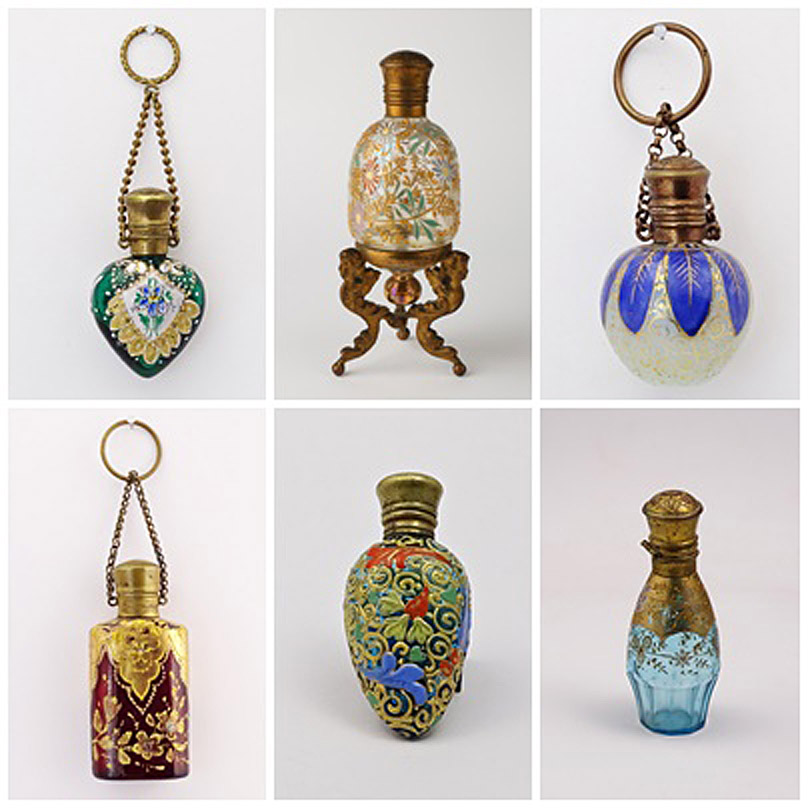
Step 2. What details do we see that provide clues as to period, country of origin?
• Cap has a very typical engraved design that we see in similar ones.
• Gilt decoration covering a large surface of the vessel is heavily applied, typical of the so-called “Moser style” seen in the second half of the 19th Century in Bohemia (Ludwig Moser & Sons is a glassmaking firm founded in Bohemia and known for intricately enameled glassware during this period).
• Can we find similar scent bottles?

• Can we find similar caps?
Step 3. What have we learned, and what else do we want to know?
Insight: All these small bottles have brass caps with engraved designs and most have chains attached. Many bottles with these features pictured on the internet, in perfume bottle books, etc., are identified as Moser or Moser-style. They also are frequently identified as having been made in Bohemia (where the Moser firm was located).
Is there other information you would like to have? For more information, look for references to answer such questions as:
• Why Bohemia had such a great production of glass? When did it start?
• Who were the main makers? Who was Moser? Why is his name applied to this style?
• Are there museums or collections that have these kinds of scent bottles?
• Were these scent bottles (and others similar) made mostly for wealthy buyers or for a newly emerging middle class?
Example 2
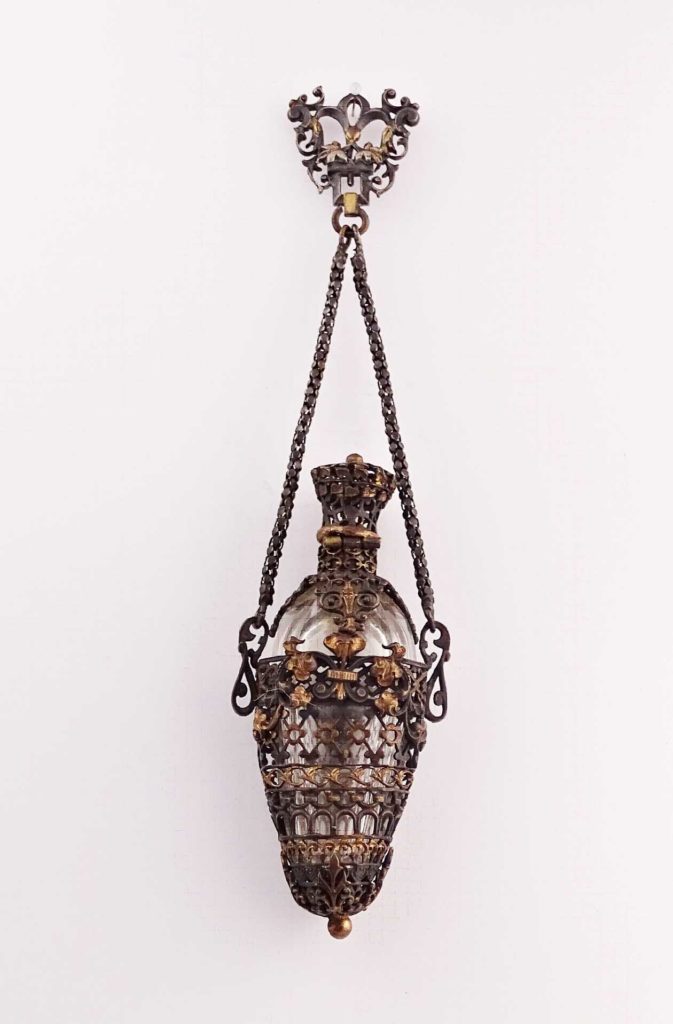
Step 1. What do we notice at the first glance?
Thick smoked glass, finely cut, enclosed in a heavy alloy metal cage executed in Rococo style, hinged perforated “mushroom” cap with belt chatelaine clip (chain is fastened from the bottle to a clip which would have then been attached to the wearer’s belt); no marks.
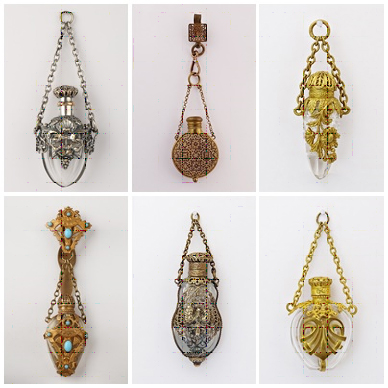
Step 2. What details do we see that provide clues as to period, country of origin?
• Rococo cage work, possibly indicating French origin.
• Combination of glass and metal elaborate cage is typical of the second half of the 19th century in France.
• “Mushroom” cap shape which is perforated, seen especially in chatelaine bottles that, while being worn, allow the perfume to diffuse around the wearer. Such caps are also characteristic of this kind of scent bottle made in France.
• Can we find similar scent bottles?
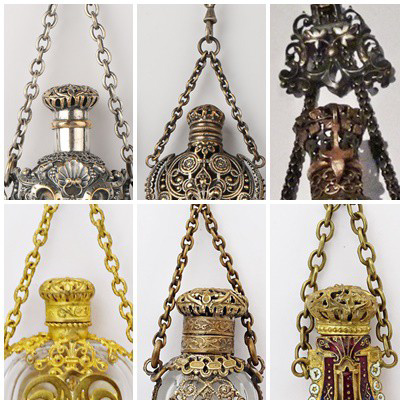
• Can we find similar caps: mushroom shaped and perforated?
Step 3. What have we learned and what else do we want to know?
Insight: These bottles all have ornate metalwork with raised repoussé decorative elements, known as the Rococo style. We learn that Rococo style was born in France in the 1730s as a reaction against the more formal and geometric Louis XIV style of decoration. It is seen in decorative arts, furniture, jewelry, architecture and more. A somewhat similar Rococo Revival style (heavier, bolder execution of ornamentation that earlier Rococo) emerged during the Second Empire (reign of Napoleon III, 1852-1870).
Is there other information you would like to have? For example, you may want to look for references to answer such questions as:
• Which are the best known and more frequently used metal alloys?
• Do we know anything about the makers of these chatelaines?
• Are there museums or collections that have these kinds of scent bottles?
• Were these scent bottles made mostly for wealthy buyers or for a newly emerging middle class?
Example 3
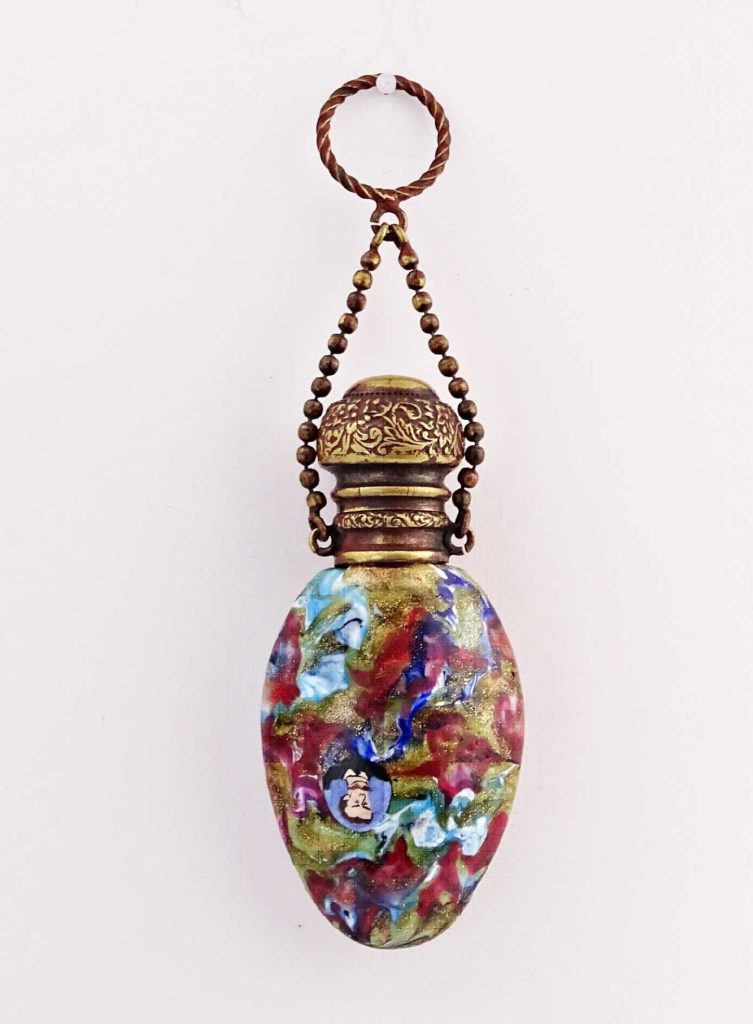
Step 1. What do we notice at the first glance?
• Glass, thick “paste” with aventurine (sparkling glass) inclusions.
• Glass contains tiny figures made in a particular artistic glassmaking technique called “millefiori.” (This is a time consuming technique involving the combining of glass rods, working at the fire.)
• Brass mount and cap with moulded foliage décor and glass stone at the top; finger chatelaine.
• No marks.
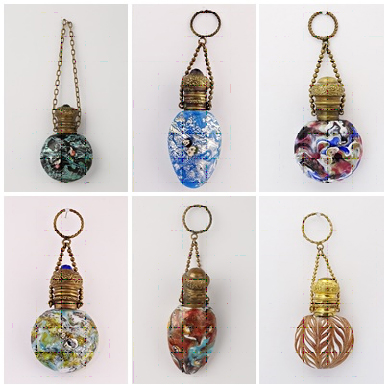
Step 2. What details do we see that provide clues as to period, country of origin?
• Myriad of glass colors, figures embedded. Even to someone who doesn’t know much about glass, this scent bottle is amazing for its colors and the decorative inclusions in the glass. This calls to mind the place where the most famous glass of the world is made: Murano, Venice, Italy.
• Brass cap, elaborate décor, stone on top, chain with ring.
• Can we find similar scent bottles?
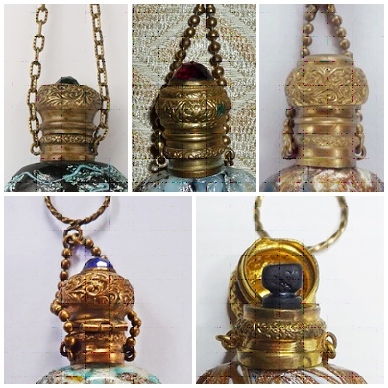
• Can we find similar caps?
Step 3. What have we learned, and what else do we want to know?
Insight: These bottles all show the glass fabrication techniques characteristic of Murano, Venice, Italy. What is the history of this island? Why is it synonymous with glass?
Is there other information you would like to have? For example, you may want to look for references to answer such questions as:
• These “portrait canes scent bottles are frequently wrongly identified as “Franchini & Bigaglia.” Why? Who were these two Italian glass masters?
• Who are the people portrayed on these bottles?
• Are there museums or public collections with this kind of scent bottles?
• Were these scent bottles made mostly for wealthy buyers or for a newly emerging middle class?
A Few Caveats
Be sure to take notes as you are examining your bottle. This will help you remember the specific features and details you find. They can also form a basis for a description of the bottle in your personal catalog or inventory.
There are often “exceptions” to the “typical” or “usual” characteristics you find in certain types of bottles. Occasionally, a bottle will have features that just don’t seem to “go together.”
You need to decide how you will classify a bottle’s origins when the glass is obviously that of a particular manufacturer and the cap has hallmarks or maker’s marks of a different country from the glassmaker. Bottles might be exported from one country, decorated in another, and then sent to a jeweler or metal manufacturer in yet another for a cap and other metalwork.
“Marriages” between bottles and caps or stoppers not original to them do occur. This may be a source of confusion in the identification process.
Time periods are not precise. Styles overlap one another. A bottle may have elements of two different design movements (e.g., Art Nouveau and Art Deco). Also, styles were copied and reproduced in later time frames (e.g., 18th century Chelsea porcelain figural bottles and their 19th century reproductions).
Some bottles may always remain a mystery!
You’re Ready to Start
Examining a bottle closely and describing it in detail are essential to finding out its origin. Using the three-step process will help you be a better observer and give you more information for beginning your research. It requires time and discipline on your part, but you will be on your way to knowing your bottles better and appreciating them more as a result.
Source: Article “Be Your Own Expert: Identifying Your Treasure Found” by Monica Magnani and the members of the Scent Bottle Research and Discussion Group, PBQ Spring 2023.
IPBA Members Participating in the Research and Discussion Group: Monica Magnani, Coordinator; Susan Arthur, Elizabeth Creech, Cynthia Faraglia, Joyce Geeser, Earline Kopriva, Judy Parker, Jeffrey Sanfilippo, Rusty Hernandez-Sanfilippo, and Teri Wirth.